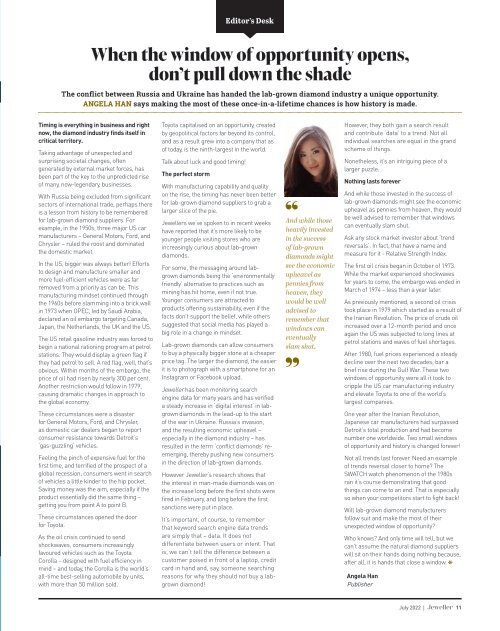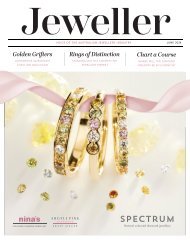Jeweller - July 2022
Door wide open: Lab-grown diamonds have a unique chance to thrive The Ego Game: Personalised jewellery is as popular as ever seen Avoid the trap: The business world is full of cliches - it's time to move on
Door wide open: Lab-grown diamonds have a unique chance to thrive
The Ego Game: Personalised jewellery is as popular as ever seen
Avoid the trap: The business world is full of cliches - it's time to move on
Create successful ePaper yourself
Turn your PDF publications into a flip-book with our unique Google optimized e-Paper software.
Editor’s Desk<br />
When the window of opportunity opens,<br />
don’t pull down the shade<br />
The conflict between Russia and Ukraine has handed the lab-grown diamond industry a unique opportunity.<br />
ANGELA HAN says making the most of these once-in-a-lifetime chances is how history is made.<br />
Timing is everything in business and right<br />
now, the diamond industry finds itself in<br />
critical territory.<br />
Taking advantage of unexpected and<br />
surprising societal changes, often<br />
generated by external market forces, has<br />
been part of the key to the unpredicted rise<br />
of many, now-legendary, businesses.<br />
With Russia being excluded from significant<br />
sectors of international trade, perhaps there<br />
is a lesson from history to be remembered<br />
for lab-grown diamond suppliers. For<br />
example, in the 1950s, three major US car<br />
manufacturers – General Motors, Ford, and<br />
Chrysler – ruled the roost and dominated<br />
the domestic market.<br />
In the US, bigger was always better! Efforts<br />
to design and manufacture smaller and<br />
more fuel-efficient vehicles were as far<br />
removed from a priority as can be. This<br />
manufacturing mindset continued through<br />
the 1960s before slamming into a brick wall<br />
in 1973 when OPEC, led by Saudi Arabia,<br />
declared an oil embargo targeting Canada,<br />
Japan, the Netherlands, the UK and the US.<br />
The US retail gasoline industry was forced to<br />
begin a national rationing program at petrol<br />
stations. They would display a green flag if<br />
they had petrol to sell. A red flag, well, that’s<br />
obvious. Within months of the embargo, the<br />
price of oil had risen by nearly 300 per cent.<br />
Another restriction would follow in 1979,<br />
causing dramatic changes in approach to<br />
the global economy.<br />
These circumstances were a disaster<br />
for General Motors, Ford, and Chrysler,<br />
as domestic car dealers began to report<br />
consumer resistance towards Detroit’s<br />
‘gas-guzzling’ vehicles.<br />
Feeling the pinch of expensive fuel for the<br />
first time, and terrified of the prospect of a<br />
global recession, consumers went in search<br />
of vehicles a little kinder to the hip pocket.<br />
Saving money was the aim, especially if the<br />
product essentially did the same thing –<br />
getting you from point A to point B.<br />
These circumstances opened the door<br />
for Toyota.<br />
As the oil crisis continued to send<br />
shockwaves, consumers increasingly<br />
favoured vehicles such as the Toyota<br />
Corolla – designed with fuel efficiency in<br />
mind – and today, the Corolla is the world’s<br />
all-time best-selling automobile by units,<br />
with more than 50 million sold.<br />
Toyota capitalised on an opportunity, created<br />
by geopolitical factors far beyond its control,<br />
and as a result grew into a company that as<br />
of today, is the ninth-largest in the world.<br />
Talk about luck and good timing!<br />
The perfect storm<br />
With manufacturing capability and quality<br />
on the rise, the timing has never been better<br />
for lab-grown diamond suppliers to grab a<br />
larger slice of the pie.<br />
<strong>Jeweller</strong>s we’ve spoken to in recent weeks<br />
have reported that it’s more likely to be<br />
younger people visiting stores who are<br />
increasingly curious about lab-grown<br />
diamonds.<br />
For some, the messaging around labgrown<br />
diamonds being the ‘environmentally<br />
friendly’ alternative to practices such as<br />
mining has hit home, even if not true.<br />
Younger consumers are attracted to<br />
products offering sustainability, even if the<br />
facts don’t support the belief, while others<br />
suggested that social media has played a<br />
big role in a change in mindset.<br />
Lab-grown diamonds can allow consumers<br />
to buy a physically bigger stone at a cheaper<br />
price tag. The larger the diamond, the easier<br />
it is to photograph with a smartphone for an<br />
Instagram or Facebook upload.<br />
<strong>Jeweller</strong> has been monitoring search<br />
engine data for many years and has verified<br />
a steady increase in ‘digital interest’ in labgrown<br />
diamonds in the lead-up to the start<br />
of the war in Ukraine. Russia’s invasion,<br />
and the resulting economic upheavel –<br />
especially in the diamond industry – has<br />
resulted in the term ‘conflict diamonds’ reemerging,<br />
thereby pushing new consumers<br />
in the direction of lab-grown diamonds.<br />
However <strong>Jeweller</strong>’s research shows that<br />
the interest in man-made diamonds was on<br />
the increase long before the first shots were<br />
fired in February, and long before the first<br />
sanctions were put in place.<br />
It’s important, of course, to remember<br />
that keyword search engine data trends<br />
are simply that – data. It does not<br />
differentiate between users or intent. That<br />
is, we can’t tell the difference between a<br />
customer poised in front of a laptop, credit<br />
card in hand and, say, someone searching<br />
reasons for why they should not buy a labgrown<br />
diamond!<br />
And while those<br />
heavily invested<br />
in the success<br />
of lab-grown<br />
diamonds might<br />
see the economic<br />
upheavel as<br />
pennies from<br />
heaven, they<br />
would be well<br />
advised to<br />
remember that<br />
windows can<br />
eventually<br />
slam shut.<br />
However, they both gain a search result<br />
and contribute ‘data’ to a trend. Not all<br />
individual searches are equal in the grand<br />
scheme of things.<br />
Nonetheless, it’s an intriguing piece of a<br />
larger puzzle.<br />
Nothing lasts forever<br />
And while those invested in the success of<br />
lab-grown diamonds might see the economic<br />
upheavel as pennies from heaven, they would<br />
be well advised to remember that windows<br />
can eventually slam shut.<br />
Ask any stock market investor about ‘trend<br />
reversals’. In fact, that have a name and<br />
measure for it - Relative Strength Index.<br />
The first oil crisis began in October of 1973.<br />
While the market experienced shockwaves<br />
for years to come, the embargo was ended in<br />
March of 1974 – less than a year later.<br />
As previously mentioned, a second oil crisis<br />
took place in 1979 which started as a result of<br />
the Iranian Revolution. The price of crude oil<br />
increased over a 12-month period and once<br />
again the US was subjected to long lines at<br />
petrol stations and waves of fuel shortages.<br />
After 1980, fuel prices experienced a steady<br />
decline over the next two decades, bar a<br />
brief rise during the Gulf War. These two<br />
windows of opportunity were all it took to<br />
cripple the US car manufacturing industry<br />
and elevate Toyota to one of the world’s<br />
largest companies.<br />
One year after the Iranian Revolution,<br />
Japanese car manufacturers had surpassed<br />
Detroit’s total production and had become<br />
number one worldwide. Two small windows<br />
of opportunity and history is changed forever!<br />
Not all trends last forever. Need an example<br />
of trends reversal closer to home? The<br />
SWATCH watch phenomenon of the 1980s<br />
ran it’s course demonstrating that good<br />
things can come to an end. That is especially<br />
so when your competitors start to fight back!<br />
Will lab-grown diamond manufacturers<br />
follow suit and make the most of their<br />
unexpected window of opportunity?<br />
Who knows? And only time will tell, but we<br />
can’t assume the natural diamond suppliers<br />
will sit on their hands doing nothing because,<br />
after all, it is hands that close a window.<br />
Angela Han<br />
Publisher<br />
<strong>July</strong> <strong>2022</strong> | 11


















